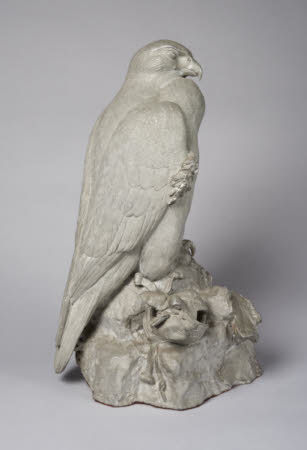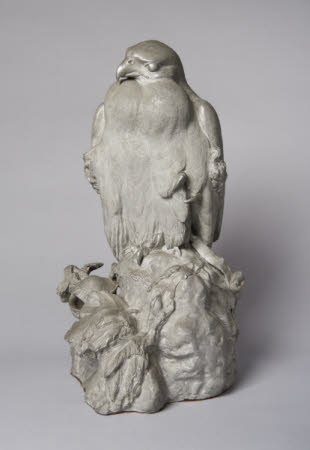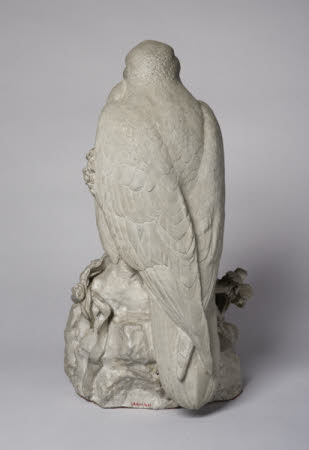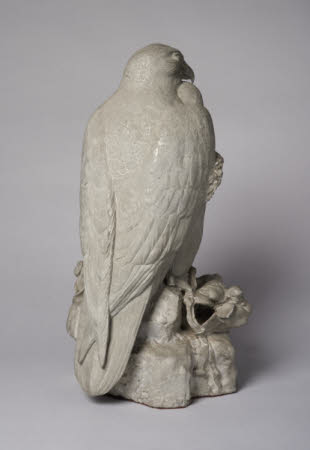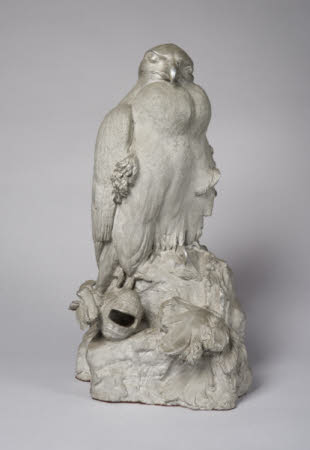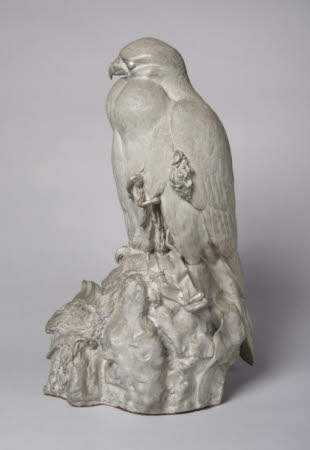A gyr falcon
John Hancock (1808-1890)
Category
Art / Sculpture
Date
1862
Materials
White metal
Measurements
475 mm (H)
Place of origin
Newcastle upon Tyne
Order this imageCollection
Cragside, Northumberland
NT 1228507
Summary
White metal sculpture; A gyr falcon; John Hancock (1808-90); 1862. A white metal statuette of a gyr falcon seated upon a rock, with its hood and jesses, by the great natural historian and taxidermist John Hancock. One of two very rare cast metal sculptures by Hancock that survive at Cragside.
Full description
A statuette cast in white metal, depicting a gyr falcon seated upon a rock, its head turned to its right, its left foot raised. The bird’s left eye is open and alert, the right eye half-closed. On the rock before the falcon are feathers and other remnants from its meal or kill; to the bird’s right is its hood and, to its left, the jesses, thin leather straps used to tether a hunting bird. Signed and dated on the rock. John Hancock is today best known as a taxidermist, who brought new levels of skills to the preparation of specimens of birds. Most of his surviving specimens, including some that he exhibited at the Great Exhibition in 1851, are in the former Hancock Museum in Newcastle, today the Great North Museum, whilst there is also a representative collection at Cragside. The Gyr Falcon and Two Green Woodpeckers at Cragside are rare examples of Hancock’s skills as a sculptor. The falcon in particular is an astonishingly fine sculpture in its own right, with every detail of the bird’s feathers carefully reproduced, the animal depicted naturalistically but without sentimentality. John Hancock was the child of another John Hancock (died 1812), a shopkeeper and keen amateur natural historian. None of his and his wife Jane Baker’s six children married, whilst no fewer than four of the siblings became involved in the study of natural history, Thomas Hancock as a geologist, Mary as a natural history draughtsman and John and his brother Albany (1806-73) as zoologists. According to Hancock’s biographer Dennis Embleton, the children had only rudimentary educations, but John and his sister Mary would wander the open country beyond Newcastle. As a young man John Hancock quickly tired of working in the family shop and instead devoted himself to the study of natural history, including plants, insects and especially birds. Hancock’s work as a taxidermist, which came to much wider attention with the display of his work at the 1851 exhibition, was characterised by a much greater attention to naturalistic presentation: ‘he taught how to combine scientific accuracy with artistic feeling’ (Embleton, p. 9), whilst his knowledge of birds became proverbial: ‘John Hancock knew birds thoroughly. At a distance he recognised them by their flight, and nearer, their movements and their notes were all familiar to him. He had observed and sketched their various fashions of plumage for each sex, age, and season, inclusive of their nuptial dresses and habits.’ (Embleton, p. 10). It seems to have been in the 1830s that John Hancock and his brother Albany became interested in modelling, with Albany making portrait busts and John figures or groups of animals and birds. The models were made in clay and then cast in plaster. Embleton listed just eight models made by John Hancock; these included ‘in plaster a Greenland Falcon, with hood at its feet’ and ‘An Iceland Falcon, in silver, for the Duke of Leeds, as a prize for the Falconry Club of Loo in Holland.’ The famous Royal Loo Hawking Club was founded by Prince Alexander of the Netherlands in 1839 and was in existence until 1855. The falcon for the Royal Het Loo club was cast in silver. As further evidence for John Hancock's occasional casts in metal from his models, Embleton also recorded that he had made a ‘beautiful bronze’ cast of an eagle with outstretched wings, using for the bronze alloy ‘an antique receipt’ and casting the sculpture ‘at the Gallowgate works of his friend Mr. James Burnett.’ He also made two casts in ‘hardened lead’ of eagles that were formerly on the gateposts of the Hancock Museum and are today on display inside the Great North Museum. The rarity of Hancock’s casts in metal suggests that they were made only to special commission, or for friends, which certainly included Sir William Armstrong. Albany and John Hancock did much to stimulate Armstrong’s love of the natural world, with John also being closely involved in advising on the landscaping of Jesmond Dene, the park given by Sir William to the people of Newcastle. The Greenland and Iceland Falcons are both types of the same basic species of gyr falcon (falco rusticolus). The cast made by Hancock in 1862 and now at Cragside must have been made from one of those models, perhaps, given the specific mention of the hood at its feet, the Greenland falcon. John Hancock seems to have had a special interest in falconry and especially enjoyed training peregrines and merlins, doing some of the training on the Newcastle Town Moor (T. Russell Goddard, History of the Natural History Society of Northumberland, Durham and Newcastle upon Tyne 1829-1929, Newcastle-upon-Tyne 1929, p. 173). At the Great Exhibition in 1851, three of Hancock’s exhibits of stuffed animals illustrated different aspects of falconry and another was of a Lammergeier falcon. The sculptural depiction of the gyr falcon at Cragside, sated after its meal, has an especially close parallel in John Hancock’s lithograph entitled the Gorged Falcon (John Hancock, A Fasciculus of Eight Drawings on Stone, of Groups of Birds, &c., by John Hancock. The whole being representations of Specimens Stuffed and Contributed by the Author to the Great Industrial Exhibition of 1851, Newcastle upon Tyne 1853). Jeremy Warren March 2022
Provenance
Armstrong collection. Transferred by the Treasury to The National Trust in 1977 via the National Land Fund, aided by 3rd Baron Armstrong of Bamburgh and Cragside (1919 - 1987).
Marks and inscriptions
Signature and date, on side of rocks:: I HANCOCK / 1862
Makers and roles
John Hancock (1808-1890), sculptor
References
Embleton, Dennis, Memoir of the life of John Hancock, 1891
